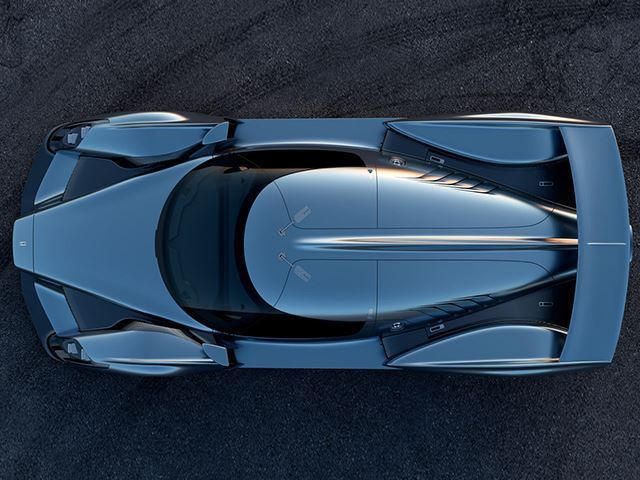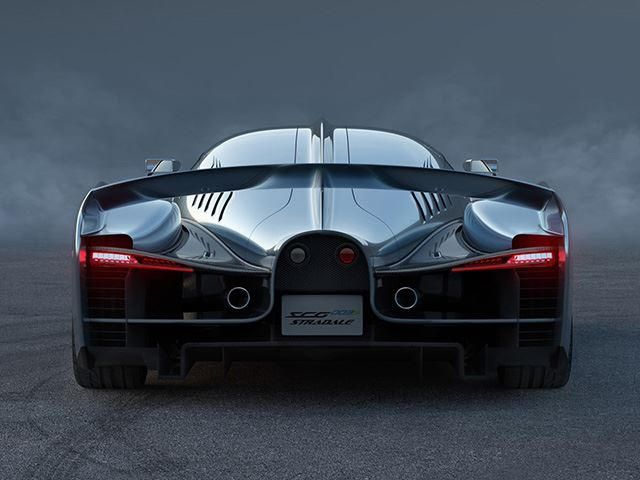
As a man possessed with racing, James Glickenhaus started his car company to fund his speed addiction, much like Enzo Ferrari did when he founded the iconic Italian supercar brand. Dismayed with cars like the Ferrari LaFerrari and McLaren P1 for their complexity, cost, and lack of racing prowess, Glickenhaus got to work building the SCG003. To him the current crop of hypercars focused too much on comfort and everyday usability and weren't as credible when it came to lap times.
What he wanted was a daily driver for the real race car driver, essentially appealing to the Lewis Hamiltons of the world who crave a barely legal LMP1 car they can bring to Cars and Coffee. It's been in the pipeline for years, but now the SCG003S is here. To keep it a daily driver, SCG makes nerve-wracking curbs a pain-free experience by attaching high-density wood blocks to vulnerable lips and diffusers, much like on an F1 car. Scratch the front lip pulling out of a driveway? Just pull out a screwdriver and replace the blocks, no $2,000 trip to the Ferrari dealership required. That theme of easy tampering is seen throughout the rest of the SCG003 lineup, which will include a track-only Competizione featuring a 545 horsepower 3.5-liter Honda V6.
There's also a road-legal version called the Stradale with a 4.4-liter twin-turbo V8 making 700 horsepower and featuring de-tuned aerodynamics and a more comfortable interior. That, of course, is relative as this is still a hardcore track machine. The third model is a road-legal version of the track-only car called the Competizione Stradale. To meet emissions requirements (the 3.5-liter V6 is not street-legal) the SCG003CS will have the same 4.4-liter reverse-flow V8 that goes in the SCG003S. Glickenhaus refused to say, but we think the secret V8 is a souped-up version of BMW's S63 engine given that it meets current emissions standards, is a 4.4-liter twin-turbo V8, and has its intake and exhaust ports switched in reverse flow fashion.
Glickenhaus said that he's worked closely with the OEM and Bosch to squeeze every ounce of horsepower, torque, efficiency, and reliability out of the engine. Smoothness of the gear changes was also on the wish list, so SCG spent time tweaking the engine an tune of the seven-speed dual-clutch gearbox made by Cima, the same transmission used by Koenigsegg. Horsepower, however, isn't the goal here. According to Glickenhaus, "There is no tire that can put down more than 700 horsepower on the street. If you have a LaFerrari with close to 1,000 horsepower, all you're doing is creating horsepower that's being regulated out by the traction control." Instead, the goal for the SCG003S was lap times.
To force it around corners as quickly as possible, Glickenhaus focused on the aerodynamics and the tires. In collaboration with Dunlop, SCG is developing a set of rubber that best suits the car's characteristics, allowing it to pull 2.7 Gs of cornering force on race slicks and 2.0 Gs on road tires. Additional assistance in this area comes from the static aerodynamic helpers. Glickenhaus took inspiration from the fastest cars around, LMP1 race cars, to design the body around road regulations and mold it to his own standard of aesthetics. The result is cutting-edge diplomacy with the wind. To stay ahead of the McLaren P1 and Ferrari LaFerrari, the SCG003S uses its design to eliminate weight, unnecessary body panels, and lift.
Cutting lift helps the 1,500 pounds of downforce do its job sans drag. This does wonders for the 2,800-pound hypercar, which, for reference, is 400-500 pounds lighter than a LaFerrari. Helping the SCG's anorexia is the body's design. To meet federal standards for minimum roof and fender height, Glickenhaus had certain points meet the line on the yardstick and drop off from there. This explains the fin on the roof as well as the points on the fenders that swoop down to lessen the overall drag area. Racing regulations also state that a car's suspension components cannot be seen from a top-down view, so SCG made sure to cover those with a fin, leaving occupants with a view of the wheels and air a place to pass unencumbered.
The rear tapers off to a point similar to the rear on the new Ford GT to further increase wind flow. Unlike the GT, the cockpit is narrower and more discriminating against those on the higher end of the BMI scale. Not that the SCG003S is an unfriendly car to drive. A powerful air conditioner was a priority for Glickenhaus, who wanted drivers to feel as refreshed as possible so they'd be focused on the track. Side mirrors are aided by cameras, which project their view onto the dash to keep a driver's eyes. These efforts help keep the SCG003S safe and approachable. Unlike race cars, street car regulations require only one setting for ABS and traction control systems. To get around this, a second steering wheel was built.
At a track, the driver simply swaps the street steering wheel for the racing wheel that has the switches controlling the aids. It's ingenious workarounds like these that show the world how SCG is a small automaker for serious racers looking for something that will turn heads, rewrite record lap times, and can be driven home from the race track. At first, Glickenhaus thought that no more than 10 customers would buy the SCG003S with its $1.3 million price tag, but he was wrong. "We have a lot more orders than that," says Glickenhaus. "When I say a lot more, I'm talking maybe 20, 30, 40, or even 50." SCG's future could get even brighter. The company has been approached by groups that want to expand SCG and take it to the big leagues.
With funding, "this could mean production facilities and production numbers as high as 5,000 cars over five years." Whether that happens or not, the SCG might have the Mercedes-AMG R50 and Aston Martin AM-RB 001 to contend with by the time it gains any prominence. For now, Glickenhaus doesn't care about those sales numbers or profit margins. As long as his car is faster and brings in enough cash to stay alive and annoy Ferrari, he'll rest easy at night.



